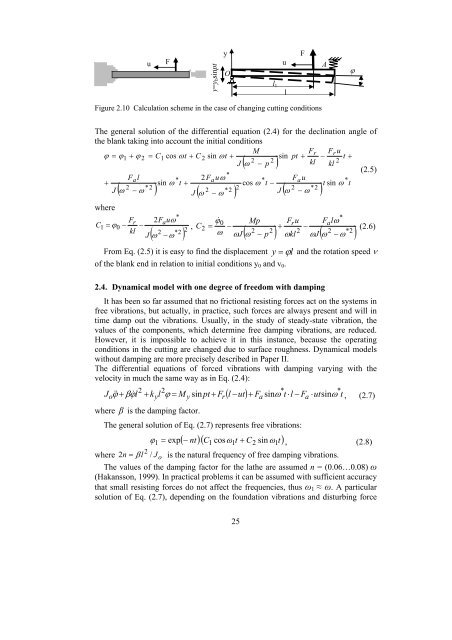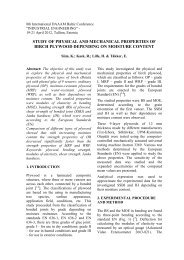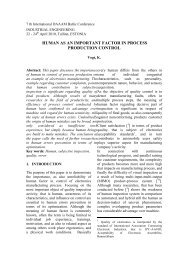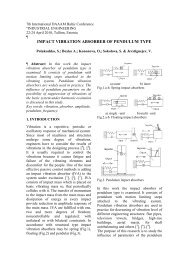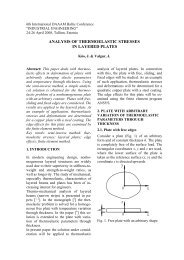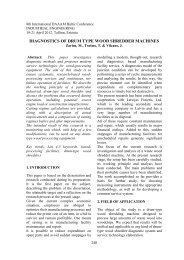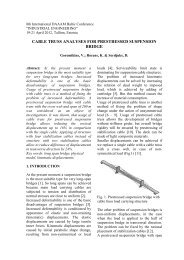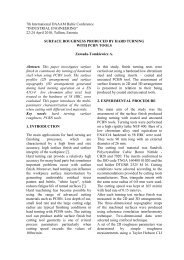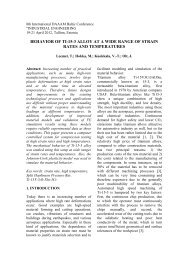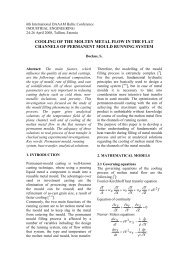Overview in PDF format - Tallinna Tehnikaülikool
Overview in PDF format - Tallinna Tehnikaülikool
Overview in PDF format - Tallinna Tehnikaülikool
You also want an ePaper? Increase the reach of your titles
YUMPU automatically turns print PDFs into web optimized ePapers that Google loves.
uFy=ybs<strong>in</strong>ptyOl 1ulFAϕFigure 2.10 Calculation scheme <strong>in</strong> the case of chang<strong>in</strong>g cutt<strong>in</strong>g conditionsThe general solution of the differential equation (2.4) for the decl<strong>in</strong>ation angle ofthe blank tak<strong>in</strong>g <strong>in</strong>to account the <strong>in</strong>itial conditionsMF F uϕ = ϕ C t C tptr r1 + ϕ 2 = 1 cos ω + 2 s<strong>in</strong> ω +s<strong>in</strong> + − t +2 2J ( p ) kl 2ω −kl(2.5)*Fal* 2Fauω* Fau*+s<strong>in</strong> ω t +cos ω t −t s<strong>in</strong> ω t2 *222 *2J ( ω − ω ) 2 *2J ( ω − ω ) J ( ω − ω )where*F 2FuωC1= ϕ0− r −aklJ2 *2( ω −ω) 2, C2 =& 0−ϕωωJMpF u*F lω+r a−2 2 2 2 *2( ω − p ) ωklωJ( ω − ω )(2.6)From Eq. (2.5) it is easy to f<strong>in</strong>d the displacement y = ϕland the rotation speed νof the blank end <strong>in</strong> relation to <strong>in</strong>itial conditions y 0 and v 0 .2.4. Dynamical model with one degree of freedom with damp<strong>in</strong>gIt has been so far assumed that no frictional resist<strong>in</strong>g forces act on the systems <strong>in</strong>free vibrations, but actually, <strong>in</strong> practice, such forces are always present and will <strong>in</strong>time damp out the vibrations. Usually, <strong>in</strong> the study of steady-state vibration, thevalues of the components, which determ<strong>in</strong>e free damp<strong>in</strong>g vibrations, are reduced.However, it is impossible to achieve it <strong>in</strong> this <strong>in</strong>stance, because the operat<strong>in</strong>gconditions <strong>in</strong> the cutt<strong>in</strong>g are changed due to surface roughness. Dynamical modelswithout damp<strong>in</strong>g are more precisely described <strong>in</strong> Paper II.The differential equations of forced vibrations with damp<strong>in</strong>g vary<strong>in</strong>g with thevelocity <strong>in</strong> much the same way as <strong>in</strong> Eq. (2.4):**( l −ut) + F s<strong>in</strong>ωt ⋅l− F ⋅uts<strong>in</strong>ωtJo& 2 2ϕ&+ βϕ&l + kylϕ = M y s<strong>in</strong> pt + Fraa , (2.7)where β is the damp<strong>in</strong>g factor.The general solution of Eq. (2.7) represents free vibrations:ϕ 1 = exp( − nt)( C1cosω1t+ C2s<strong>in</strong>ω1t) , (2.8)2where 2n = β l / Jois the natural frequency of free damp<strong>in</strong>g vibrations.The values of the damp<strong>in</strong>g factor for the lathe are assumed n = (0.06…0.08) ω(Hakansson, 1999). In practical problems it can be assumed with sufficient accuracythat small resist<strong>in</strong>g forces do not affect the frequencies, thus ω 1 ≈ ω. A particularsolution of Eq. (2.7), depend<strong>in</strong>g on the foundation vibrations and disturb<strong>in</strong>g force25


